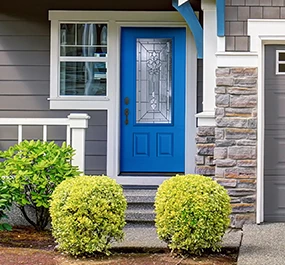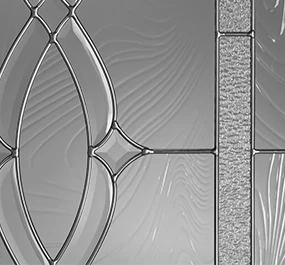Winter isn’t received with fanfare from some, mostly for obvious reasons. If you are like most homeowners, you prefer to cozy up by the fire with a cup of hot cocoa and watch the snow fall instead of spending time outside in the bone-chilling cold.
There’s nothing wrong with spending most of the winter indoors, especially if your home’s exterior door is capable of withstanding the cold weather. Preventing cold air from entering your home is essential for an enjoyable winter season. This is your guide to how to stop cold air coming through doors and a look at the best exterior doors for cold weather.
The Importance of Proper Insulation for Your Exterior Doors
Exterior door insulation is your home’s initial line of defense against winter’s wrath. However, no two insulation products are equally effective against snow, wind, ice, and other winter weather. Plastpro’s fiberglass doors have been carefully designed to maximize home insulation and energy efficiency through their unique polyurethane foam core. Insulate the right way and you’ll prevent cold drafts from moving inward and disrupting your living space.
A well-insulated door also prevents your winter home heating bills from increasing. Plastpro’s lineup of energy-efficient doors fortifies your living space against the brutality of winter, helping you live comfortably regardless of how brutal it might get outside.
Combine a new Plastpro door featuring cold-resistant materials with fresh gap sealing and you’ll prevent those cold air drafts from moving inward. However, if you are like most homeowners you aren’t sure where to start. Let’s begin the search for a new exterior home door with a look at insulation ratings.
Understanding Insulation Ratings
An exterior door with a high R-value can withstand the harsh winter weather. Balance R-value with door style and price, leaning toward those with higher R-values with superior insulation. Choose a door with a low R-value and you’ll find it struggles to prevent outdoor air from moving inward.
As an example, an exterior door with an R-value of R-16 is better insulated than an exterior door with an R-8 R-value. However, the difference in numbers does not indicate that the R-16 door has eight times better the insulation than R-8 doors. Rather, such doors have less than a 10% thermal resistance difference.
Selecting the Right Insulation Material
Check out the exterior door options and you’ll find they are made of different materials and also have distinct insulation material. When it comes to the best exterior doors for cold weather, fiberglass doors have superior insulation with significant thermal resistance. However, an exterior door’s insulation material is only one piece of the home's winter heating puzzle.
Combine a new Plastpro fiberglass door with the following additional door and home elements to keep winter weather outside where it belongs:
- Window insulation kits
- Weatherstrips
- Door sweeps
- Window film
Even recaulking doors and windows to shore up those pesky gaps will help keep the cold door outside.
Sealing Gaps: How to Stop Cold Air Coming Through the Door
Grab a magnifying glass, open up your door, and take a close look at it along with the frame and floor. You’ll likely see at least one gap when analyzing your door’s inadequacies. Even a tiny gap has the potential to let a considerable amount of air inward.
The challenge lies in pinpointing the exact locations of gaps and addressing them to improve your home’s energy efficiency. The application of caulk to gaps and cracks seals those open spaces. Industry experts often advise adding removable caulking atop a specialized gap filler.
Some homeowners use a clay-like material called mortite atop a roll that is pressed into gaps in windows to prevent winter winds from moving inward. Once summer rolls around, all you have to do is peel the mortite away.
If you find especially large gaps, consider using foam rope filler, and trimming any remnants with scissors. When in doubt, lean on good old weatherstripping tape. Add weatherstripping tape to cracks/gaps in door frames and you’ll prevent moisture from accumulating. The strategic and precise addition of weatherstripping tape also prevents air from moving inward.
Finding and Fixing Door Leaks
A visual analysis of the door, its surrounding frame, and the floor below helps identify leaks. Stand behind the closed door on a windy day, moving your hands along the entirety of the door and nearby areas to pinpoint drafts. If the temperature drops or you notice air movement when the wind picks up- this is an indication that a leak is present.
Add caulk and weatherstripping to address air leaks as appropriate. In general, it is best to use weatherproof caulking for gaps that are less than a quarter-inch in size. Expandable foam spray is ideal for gaps that are greater than a quarter-inch in size.
Choosing Weatherstripping for Your Doors
Regular weatherstripping tape, sometimes rubberized, can be applied to cracks and gaps with ease. It is the subtleties of measuring and application that determine the weatherstripping tape efficacy.
Carefully cut weatherstripping strips to match the dimensions of the area in question. Peel the sealing and stick it appropriately to seal gaps. Homeowners with painted doors should give consideration to rubber sealing that blends in for visual uniformity, without damaging the paint.
Best Exterior Doors for Cold Weather: Features to Look For
Install a new exterior door designed for cold weather and you’ll find it is an investment that gradually pays for itself. Thick, fiberglass doors with double-pane windows contain air pockets between the panes to prevent cold outdoor air from penetrating. This exterior door design also decreases window conductivity, lowering home heating costs and keeping outdoor noise outside of your peaceful home.
Do your due diligence and you’ll find there are several Plastpro cold-resistant doors to choose from. Take your time when reviewing door options ranging from trimmable doors, to those rated to withhold storms to a wide range of standard fiberglass doors suitable for any home style.
Cold-Resistant Door Materials
It is imperative that you pick the right door material for continued comfort. Opt for a cold-resistant door material and you’ll find it prevents the harsh wind and other nasty winter elements from moving inward.
Fiberglass doors are rigid, formidable barriers between everything outside and your comfy home interior. Check out Plastpro’s fiberglass door options and it won’t take long to find one that is perfect for your home.
Upgrading to Energy-Efficient Doors
Have you noticed an increase in your home heating and cooling bills? Perhaps you can feel a light draft when you walk by your front or back door. These are signs that the time has come to upgrade to an energy-efficient door.
Plastpro’s fiberglass doors are some of the best exterior doors for cold weather as they were carefully designed to meet energy efficiency standards. Energy-efficient doors ultimately save you a bundle of money on home heating and cooling bills in the years ahead.
DIY Door Winterization: A Step-by-Step Guide
You have the power to winterize your home’s front door. This is your DIY guide to winterizing the entryway for security, more affordable utility bills, and the peace of mind and comfort every homeowner deserves.
The Winterization Process
Winterizing a door begins with an analysis of the glass. If the glass is damaged, worn, or doesn’t fit right, replace it with an insert. Consider the merits of a custom insert. Double-pane glass is ideal as it decreases drafts. If you’re in the process of replacing your door, consider choosing a product that allows for the glass to be switched without changing the entire door. However, if you prefer to avoid glass replacement, be proactive by adding weatherstripping as appropriate.
The addition of a door curtain will also help to minimize the impact of strong winds, drafts, and leaks. Be careful when selecting a curtain for your front or back door. There are meaningful differences in curtain material and quality. Choose a thick, thermal insulated curtain and it will make a meaningful impact on the temperature and comfort of the areas near the front door.
Above all, prioritize the application of weatherstripping tape. However, if you still notice air leaking through your door, it might be wise to add a draft stopper consisting of fabric in a tube form positioned along the door bottom.
Finally, don’t forget to closely analyze door and window caulking. If caulking from a previous winter is diminished or gone, add new caulking to those spots. The addition of caulking seals those spaces, preventing cold air from moving inward.
Why Choose Plastpro for Your Cold Weather Door Solutions
Choose a Plastpro cold air-resistant door for your home and you’ll find the upcoming winter is that much more comfortable and affordable, especially when it comes to home heating costs. Plastpro’s commitment to energy efficiency, quality, and innovation ensures your home is capable of withstanding cold weather head-on.
In addition to fiberglass exterior doors, we also provide door accessories ranging from sidelights to hinges, speakeasies, and more. Visit the Plastpro distributor locator page to find a local provider.



